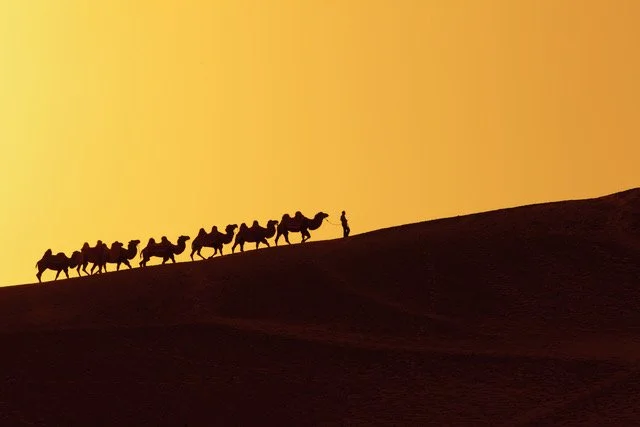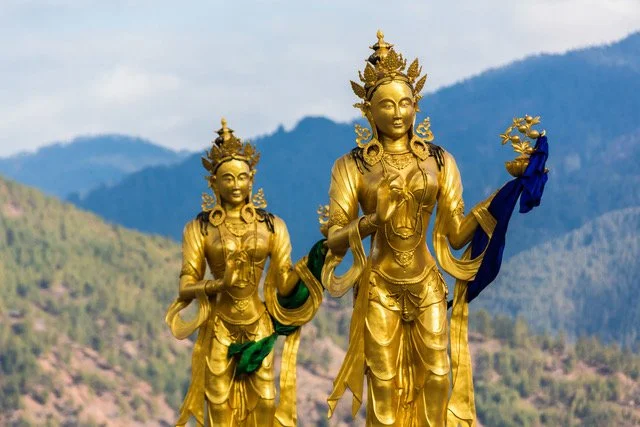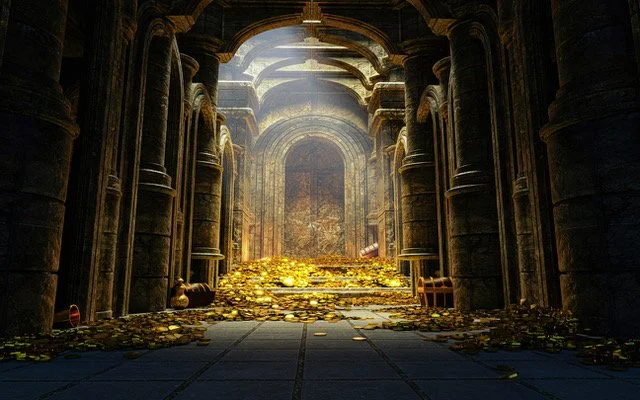Bön: The Ancient Faith That Survived Fire, Exile, and the Lure of Lost Treasure
By B.A. Crisp
From Persian fire temples to Himalayan warrior spirits, this primordial consciousness has roots that stretch across Eurasia—and a mystery that remains sealed somewhere beyond the northern snows.
When most people think of Tibetan spirituality, the image of maroon or saffron-robed Buddhist monks chanting in incense-filled temples comes to mind. Yet, hidden behind the towering Himalayas lies Bön, a tradition so ancient that even Tibetan Buddhist's refer to it as primordial. Original Bön allegedly predates the last Ice Age and is considered the “dharma” (truth) of the world.
Later, yungdrung Bön, its prodigy, became a full set of shamanic rites—a complete cosmology, a priesthood, and a code of life to decode consciousness. Some scholars believe it predates even the Vedic traditions of India, drawing from a shared Indo-Iranian religious heritage.
According to Bön’s scripture, the faith was founded by Tonpa Shenrab Miwoche between 16,000-18,000 years ago in a kingdom called Olmo Lungring—a land many link with ancient Central Asia. In this telling, Bön predates both Buddhism and the known history of human civilization. The oldest form of organized Bön—what scholars call “Yungdrung Bön” is slightly different from today’s “Eternal Bön”— and is claimed within its own tradition to be thousands of years old, originating in the mythical kingdom of Olmo Lungring long before the rise of Tibetan civilization.
Scholars, meanwhile, trace Eternal Bön and its archaeological roots to between four and six thousand years ago, pointing to rock art, burial mounds, and shamanic artifacts in western Tibet. Its organized form, complete with texts, emerged between the 8th and 11th centuries CE—but its spiritual DNA reached far, far beyond the Tibetan plateau. Today, Bön survives as both an independent tradition and a recognized school within Tibetan Buddhism. Its lamas preserve rituals, myths, and mantras that could be the last living fragment of a forgotten spiritual continuum stretching from Europe’s Bronze Age stone circles to the fire altars of Persia and the monasteries of Tibet.
Persian Fires on the Roof of the World
Cultural cross-pollination between Persia and Tibet was possible through the Silk Road long before Buddhism arrived. The Achaemenid and later Sassanian empires extended influence far into Central Asia, where ideas could flow into the highlands of Tibet.
The possibility that Bön’s roots stretch back to Zoroastrianism in ancient Persia comes from four striking parallels:
Fire Worship – Both traditions revered flame as the earthly manifestation of truth and cosmic order.
Dualistic Cosmology – A timeless struggle between light and darkness runs through both belief systems.
Priestly Castes – The Bön gshen resemble Zoroastrian magi, trained in ritual, astrology, and protective magic.
Mythic Homelands – The Zoroastrian Airyana Vaejah echoes Bön’s Olmo Lungring, both described as pristine, central realms from which divine knowledge flowed.
It was the Silk Road, which provided the perfect highway for ideas about the cosmos, consciousness, and human enlightenment, allowing Iran, Central Asia, and Tibet to trade more than silk or jade—but myths, gods, and spiritual writings/teachings, and rituals. The nomadic Scythians, Saka, and other Indo-European steppe peoples roamed from the Black Sea to the Altai Mountains, bridging Europe, Persia, and the Tibetan frontier. They may have carried a common mythic and ritual vocabulary—fire cults, sky gods, mother goddesses, and warrior brotherhoods—that took root in Tibet’s ancient Bön.
Moreover, Bön’s gods and goddesses look nothing like the serene Buddhas of later Tibet. They are elemental beings with cosmic authority:
Sipe Gyalmo – “Queen of the World,” a terrifying protectress who rides a mule across the night sky.
Shenlha Ökar – Lord of White Light, the embodiment of compassion and the cosmic order.
Yeshe Walmo – The wisdom goddess guarding Bön’s hidden treasures.
Werma Spirits – Noble warrior deities linked to protection, empowerment, and the defense of sacred lands.
These latter beings, the Werma, are considered half-divine, part-human reincarnated hybrids, carrying traces of pre-Zoroastrian Iranian cults and even Bronze Age European symbolism.
Werma: The Shambala Noble Warriors
The idea of a noble warrior of Shambala—a sacred champion defending the light—exists in both later Tibetan Buddhist Kalachakra lore and much earlier Bön myth. In Bön, the warrior ideal blends martial skill with spiritual discipline and supernatural abilities, seeing the battlefield and life as both a physical and metaphysical arena. In other words, the spiritual and earthly worlds are never separate from one another, but interconnected and interdependent. And spirit exists in everything.
This warrior archetype may connect to Indo-European warrior cults that revered the cosmic struggle:
The Zoroastrian Rathaestar (chariot warriors of truth)
The Vedic ksatriya class (defenders of dharma)
The European Celtic and Germanic “warrior bands” sworn to gods of light
The Shambala warrior in Bön isn’t just a soldier—he or she is a protector of cosmic order against chaos, much like the Persian hero Rostam or the Norse god Tyr.
The Werma are central to Bön’s vision of the noble warrior—a figure who embodies courage, spiritual discipline, and the defense of cosmic order. Werma blend martial prowess with mystical power, bridging the human and spirit worlds. In this sense, they echo the Indo-European warrior archetype: the Zoroastrian Rathaestar (chariot-warrior of truth), the Vedic ksatriya (guardian of dharma), and the Germanic and Celtic warrior bands sworn to the gods of light. There are tantalizing hints that Bön may preserve echoes of an ancient pan-Eurasian belief system. Far from being just “pre-Buddhist shamanism,” Bön may in fact be the Himalayan branch of a once-unified Indo-European-Iranian religious tree—one whose roots dig deep into humanity’s oldest stories.
What is a Bönpo?
A Bönpo is a practitioner of the Bön tradition — which today means one of two things:
Lay Bönpo – Someone who follows Bön’s ethical codes, participates in rituals, keeps household shrines, and receives blessings and empowerments.
Monastic Bönpo – A fully ordained monk or nun in the Yungdrung Bön tradition, living according to monastic vows at Bön monasteries like Menri (India) or Triten Norbutse (Nepal).
Being a Bönpo is is a spiritual calling that bridges shamanic earth-wisdom and high tantric philosophy to realize full human consciousness as a bridge between Earth and Cosmic Consciousness.
Initiation into the Esoteric & Magical Bön, its most secret branch, is often realized through the Mother Tantra Cycle (Ma rgyud) and related dzogchen (great perfection) teachings, which blend visionary practice, deity yoga, and elemental shamanism. There are also prerequisites: Spiritual Refuge – Accepting Tonpa Shenrab (Bön founder) and the Three Jewels of Bön (Buddha, Dharma, Sangha), Preliminary Practices (Ngöndro) – typically includes 100,000 prostrations, mantra accumulations, mandala offerings, and purification rituals. And having a core Moral Foundation – A Commitment to the Ten Virtuous Actions and avoidance of the Ten Non-virtues.
The most secret mantras include a teacher relationship where a direct connection with a recognized reincarnated Bön lama is essential; esoteric transmissions are passed person-to-person. These include:
The Esoteric Gateways, Wang (Empowerment) – The lama bestows the power to visualize and work with specific deities or mandalas.
Lung (Reading Transmission) – The oral reading of the root text, which “plants the seed” of the teaching in the student’s mind stream.
Tri (Instruction) – Direct explanation of how to meditate, visualize, and apply the practice.
In Bön, the most secretive and powerful initiations are guarded and only given to disciples who have shown stability, compassion, and perseverance — because these practices are believed to directly interface with both subtle and highly powerful energies and spirit worlds.
Bön’s Ingenious Act of Survival After being Outlawed: Hidden Treasures
Consequently, by the late 8th century, the Tibetan Empire had officially adopted Buddhism. Under King Trisong Detsen, Indian Buddhist masters such as Padmasambhava gained royal patronage, while Bön priests were denounced as sorcerers. Royal edicts outlawed Bön rituals, destroyed temples, and ordered sacred texts to be burned. Many priests were executed; others fled to remote Himalayan valleys or across the borders into Nepal, Bhutan, and Mongolia. Bön’s survival would depend on an ingenious act of spiritual resistance: hiding its scriptures and artifacts as secret treasures.
In Bön tradition, treasures are sometimes grouped by cardinal direction—Northern Treasure, Southern Treasure, Central Treasure, Eastern Treasure—each tied to a particular guardian land and cycle of teachings.
The Northern Treasure (Byang gter) is the most mysterious because it remains hidden and undiscovered, possibly in Central Asia or the legendary kingdom of Tagzig Olmo Lungring (Bön’s homeland, often identified with regions near ancient Persia). This treasure supposedly contains the earliest, most complete cosmological and tantric teachings on super consciousness, uncorrupted by later Tibetan or Buddhist influence. Some modern Bönpo lamas suggest it is still guarded by Werma warrior spirits and that those who try to take it prematurely will be turned back by storms, illusions, or even disappear entirely. Bön priests, called gshen, concealed these ancient treasures in three realms:
Earth Treasures – Sealed in caves, mountains, and beneath temples.
Water Treasures – Sunk in lakes and rivers, guarded by serpent spirits (nagas).
Mind Treasures – Encoded in symbols and visions that future reincarnations could “remember” at the destined time.
One of the most famous guardians of this knowledge was Drenpa Namkha, who outwardly practiced Buddhism to avoid persecution while secretly safeguarding Bön’s heart teachings.
In the early 11th century, treasure revealer Shenchen Luga unearthed the Central Treasure (Dbus gter) in the heart of Tibet. This vast collection included:
Creation Myths & Cosmology – The cosmic egg, the birth of gods, and the struggle between light and darkness.
Ritual Magic – Healing rites, protective charms, weather control.
Tantric Practices – Visualization and mantra cycles of deities like Sipe Gyalmo and Shenlha Ökar.
Dzogchen Teachings – Direct introduction to rigpa, or pure awareness.
Ethical Codes – Guidance for lay followers and monastics.
These texts reestablished Bön as a fully organized religious system—Yungdrung Bön and then “Eternal Bön”—complete with monasteries, monastic rules, and a canon rivaling that of Buddhism.
Other treasure cycles were found in Bhutan, Sikkim, Mount Kailash, and eastern Tibet. The Southern Treasure (Lho gter) is linked to hidden valleys and tantric rites. The Western Treasure (Nub gter) near Mount Kailash, contains advanced cosmological and tantric texts, while the Eastern Treasure (Shar gter) are remnants and scattered revelations in Kham and Amdo, rich in local Werma practices and geomantic lore, though never codified as a single collection. Then we have the mysterious Northern treasure, which has never been found.
The Forgotten Mystery of the Northern Treasure
The Northern Treasure (Byang gter)—is the most tantalizing of all. It is said to be hidden beyond the Kunlun Mountains, perhaps in the legendary Tagzig Olmo Lungring, Bön’s homeland. This cache allegedly contains the purest and most complete cosmological teachings of consciousness. It is said in visions to be located in a ‘lost valley’ inside a hidden temple, where one must meet “a king who is not a king”. Prophecy warns that the Northern Treasure will only be revealed to a reincarnated goddess of compassion during a time of global spiritual crisis, when the balance between light and darkness hangs by a thread. Some Bön lamas say it is guarded by Werma warrior spirits, and that those who try to find it prematurely will be turned back by blizzards, driven to madness, or suffer hitch-hiker effects of malevolent spirits, or simply vanish into the snow.
No one knows if the Northern Treasure truly exists—but since the Southern, Eastern, and Western treasures were discovered, it is assumed to be true.
And so, the question remains: Is the Northern Treasure a sealed chest of scrolls buried beyond the snow mountains… …or is it a portal to a forgotten dimension of the human spirit, waiting for the moment when the world is ready to receive it?





